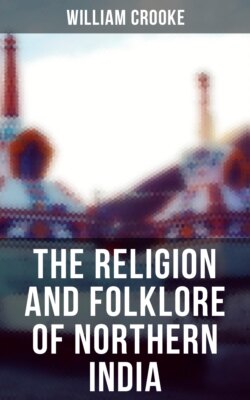Читать книгу The Religion and Folklore of Northern India - William Crooke - Страница 42
На сайте Литреса книга снята с продажи.
Mountain-worship among the Drâvidians.
ОглавлениеTable of Contents
But, deeply rooted as the veneration for mountains is in the minds of the early Aryans, there is reason to suspect that this regard for mountains may be a survival from the beliefs of non-Aryan races whom the Hindus supplanted or absorbed. At any rate, the belief in the sanctity of mountains widely prevails among the non-Aryan or Drâvidian races. Most of these peoples worship mountains in connection with the god of the rain. The Santâls sacrifice to Marang Bura on a flat rock on the top of a mountain, and after feasting, work themselves up into a state of frenzy to charm the rain. The Korwas and Kûrs worship in the same way Mainpât, a plateau in the mountainous country south of the Son. The Nâgbansis and the Mundâri Kols worship a huge rock as the abode of the “great god,” Baradeo.142 So, in Garhwâl in the Chhipula pass is a shrine to the god of the mountain. At Tolma is a temple to the Himâlaya, and below Dungagiri in the same valley is a shrine in honour of the same peak.143 In Hoshangâbâd in the Central Indian plateau, Sûryabhân or “Sun-rays” is a very common name for isolated round-peaked hills, on which the god is supposed to dwell, and among the Kurkus, Dungardeo, the mountain god, resides on the nearest hill outside the village. He is worshipped every year at the Dasahra festival with a goat, two cocoa-nuts, five dates, with a ball of vermilion paste, and is regarded by them as their special god.144 The idea that dwarfs, spirits, and fairies live on the tops of mountains is a common belief in Europe.
As in the Himâlaya, one of the main peaks, Nandâ Devî, has been identified with Pârvatî, the mountain goddess, so the aborigines of the Central Provinces have in Kattarpâr, the Kattipen of the Khândhs, a special deity of ravines, as Rhœa Sybeli was to the Etruscans.145 In the Mirzapur hills the aboriginal tribes have an intense respect for mountains. On the Mâtra hill lives a Deo or demon known as Darrapât Deo. When Râvana abducted Sîtâ he is said to have kept her on this hill for some time, and her palanquin, turned into stone, is there to this day. No one ascends the mountain through fear of the demon, except an Ojha or sorcerer, who sacrifices a goat at the foot of the hill before he makes the attempt. So, in Garhwâl the peak of Barmdeo is sacred to Devî, and none can intrude with impunity. A Faqîr who ventured to do so in the days of yore was pitched across the river by the offended goddess.146 On another Mirzapur hill, Chainpur, lives Kotî Rânî, who is embodied in the locusts which usually are found there. Similarly Pahâr Pando is a mountain deity of the Dharkârs, a sub-caste of the Doms. Bansaptî Mâî, who is half a forest and half a mountain goddess, lives on Jhurma hill, and if any one dares to sing in her neighbourhood, he becomes sick or mad. These mountain demons often take the form of tigers and kill incautious intruders on their domains. On the Aunri hill are two dreaded demons, Deorâsan and Birwat, the latter a Bîr or malignant ghost of some one who died a violent death. They rule the hail, and at harvest time the Baiga offers a goat, and spreading rice on the ground, prays—“O Lord Mahâdeva! May this offering be effectual.” Mangesar, the rugged peak which frowns over the valley of the Son, is a popular local god of the various Kolarian races, and a shrine to Bâba or Râja Mangesar, “the father and the king,” is found in many of their villages.
